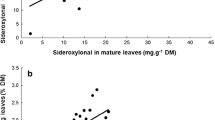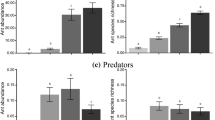Abstract
The marsupials that eat Eucalyptus in south-eastern Australia provide an example of animals with similar niche requirements occurring sympatrically. They certainly differ in size, ranging from about 1 kg in the greater glider (Petauroides volans) and the closely related common ringtail possum (Pseudocheirus peregrinus), to 4 kg (common brushtail possum, Trichosurus vulpecula) and up to 15 kg in the koala (Phascolarctos cinereus). All species, however, may eat considerable amounts of eucalypt foliage, often favouring the same species, and thus appear to compete for food. In order to better understand the degree of competition for food, we measured feeding by the greater glider in response to increasing concentrations of a specific group of eucalypt plant secondary metabolites (PSM), the sideroxylonals, and then compared it to results published for the other species. The greater glider was more resilient than the other species to increasing concentrations of sideroxylonals. We suggest this allows gliders to feed on leaves from the eucalypt subgenus, Symphyomyrtus, while its small size and gliding ability allow it to feed where koalas cannot, on the young leaves on top of the canopy. In contrast, the common ringtail possum is well adapted to feeding from species of the subgenus Eucalyptus, which do not produce sideroxylonals but contain less available nitrogen (AvailN) than do the symphyomyrtles. These ‘nutritional niches’ segregate the forest and along with other factors, such as generalist and specialist feeding strategies and differences in body size and requirements for shelter, presumably minimise competition between the marsupial species.


Similar content being viewed by others
References
Albrecht M, Gotelli NJ (2001) Spatial and temporal niche partitioning in grassland ants. Oecologia 126:134–141
Behmer ST, Joern A (2008) Coexisting generalist herbivores occupy unique nutritional feeding niches. Proc Natl Acad Sci USA 105:1977–1982
Braithwaite LW, Turner J, Kelly J (1984) Studies on the arboreal marsupial fauna of eucalypt forests being harvested for woodpulp at Eden N.S.W. III. Relationships between faunal densities, eucalypt occurrence and foliage nutrients, and soil parent materials. Aust Wildl Res 11:41–48
Chilcott MJ, Hume ID (1985) Coprophagy and selective retention of fluid digesta—their role in the nutrition of the common ringtail possum, Pseudocheirus peregrinus. Aust J Zool 33:1–15
Cork SJ (1986) Foliage of Eucalyptus punctata and the maintenance nitrogen requirements of koalas, Phascolarctos cinereus. Aust J Zool 34:17–23
DeGabriel JL, Wallis IR, Moore BD, Foley WJ (2008) A simple, integrative assay to quantify nutritional quality of browses for herbivores. Oecologia 156:107–116
DeGabriel JL, Moore BD, Foley WJ, Johnson CN (2009) The effects of plant defensive chemistry on nutrient availability predict reproductive success in a mammal. Ecology 90:711–719
DeGabriel JL, Moore BD, Marsh KJ, Foley WJ (2010) The effect of plant secondary metabolites on the interplay between the internal and external environments of marsupial folivores. Chemoecology 20:97–108
Degabriele R, Dawson TJ (1979) Metabolism and heat-balance in an arboreal marsupial, the koala (Phascolarctos cinereus). J Comp Physiol 134:293–301
Eschler BM, Pass DM, Willis R, Foley WJ (2000) Distribution of foliar formylated phloroglucinol derivatives amongst Eucalyptus species. Biochem Syst Ecol 28:813–824
Finke DL, Snyder WE (2008) Niche partitioning increases resource exploitation by diverse communities. Science 321:1488–1490
Foley WJ (1987) Digestion and energy-metabolism in a small arboreal marsupial, the greater glider (Petauroides volans) fed high-terpene Eucalyptus foliage. J Comp Physiol B 157:355–362
Foley WJ, Hume ID (1987) Nitrogen requirements and urea metabolism in two arboreal marsupials, the greater glider (Petauroides volans) and the brushtail possum (Trichosurus vulpecula), fed Eucalyptus foliage. Physiol Zool 60:241–250
Foley WJ, Kehl JC, Nagy KA, Kaplan IR, Borsboom AC (1990) Energy and water metabolism in free-living greater gliders, Petauroides volans. Aust J Zool 38:1–9
Ganzhorn JU (1988) Food partitioning among Malagasy primates. Oecologia 75:436–450
Ganzhorn JU (1989) Niche separation of seven lemur species in the eastern rainforest of Madagascar. Oecologia 79:279–286
Heinsohn TE, Barker R (2006) Observations of scavenging carnivory by the common brushtail possum Trichosurus vulpecula on macropod carcasses in Namadgi National Park, montane southeastern Australia. Aust Zool 33:295–296
Hutchinson GE (1959) Homage to Santa Rosalia or why are there so many kinds of animals. Am Nat 93:145–159
Kleiber M (1932) Body size and metabolism. Hilgardia 6:315–353
Lawler IR, Foley WJ, Eschler BM, Pass DM, Handasyde K (1998) Intraspecific variation in Eucalyptus secondary metabolites determines food intake by folivorous marsupials. Oecologia 116:160–169
Marsh KJ, Wallis IR, Foley WJ (2003) The effect of inactivating tannins on the intake of Eucalyptus foliage by a specialist Eucalyptus folivore (Pseudocheirus peregrinus) and a generalist herbivore (Trichosurus vulpecula). Aust J Zool 51:31–42
McArthur C, Sanson GD (1993) Nutritional effects and costs of a tannin in two marsupial arboreal folivores. Funct Ecol 7:697–703
McLean S, Brandon S, Davies NW, Foley WJ, Muller HK (2004) Jensenone: biological reactivity of a marsupial antifeedant from Eucalyptus. J Chem Ecol 30:19–36
Moore BD, DeGabriel JL (2012) Integrating the effects of PSMs on vertebrate herbivores across spatial and temporal scales. In: Iason GR, Dicke M, Hartley SE (eds) The ecology of plant secondary metabolites: from genes to global processes. Cambridge University Press, Cambridge, pp 227–247
Moore BD, Wallis IR, Marsh KJ, Foley WJ (2004a) The role of nutrition in the conservation of the marsupial folivores of eucalypt forests. In: Lunney D (ed) Conservation of Australia’s forest fauna, 2nd edn. Royal Zoological Society of New South Wales, Mosman
Moore BD, Wallis IR, Pala-Paul J, Brophy JJ, Willis RH, Foley WJ (2004b) Antiherbivore chemistry of Eucalyptus−cues and deterrents for marsupial folivores. J Chem Ecol 30:1743–1769
Moore BD, Wallis IR, Wood JT, Foley WJ (2004c) Foliar nutrition, site quality, and temperature influence foliar chemistry of tallowwood (Eucalyptus microcorys). Ecol Monogr 74:553–568
Moore BD, Foley WJ, Wallis IR, Cowling A, Handasyde KA (2005) Eucalyptus foliar chemistry explains selective feeding by koalas. Biol Lett 1:64–67
Nagy KA, Martin RW (1985) Field metabolic rate, water flux, food consumption and time budget of koalas, Phascolarctos cinereus (Marsupialia Phascolarctidae) in Victoria. Aust J Zool 33:655–665
Noble IR (1989) Ecological traits of the Eucalyptus L’herit Subgenera Monocalyptus and Symphyomyrtus. Aust J Bot 37:207–224
Packard GC, Boardman TJ (1987) The misuse of ratios to scale physiological data that vary allometrically with body size. In: Feder ME, Bennett AF, W.W B, Huey RB (eds) New directions in ecological physiology. Cambridge University Press, Cambridge, pp 216–239
Pahl LI (1987) Feeding-behavior and diet of the common ringtail possum, Pseudocheirus-Peregrinus, in Eucalyptus woodlands and Leptospermum thickets in southern Victoria. Aust J Zool 35:487–506
Pryor LD (1959) Species distribution and association in Eucalyptus. In: Keast A, Crocker RL, Christian CS (eds) Biogeography and ecology in Australia. W. Junk, The Hague, pp 461–471
Schoener TW (1974) Resource partitioning in ecological communities. Science 185:27–39
Smith AP, Ganzhorn JU (1996) Convergence in community structure and dietary adaptation in Australian possums and gliders and Malagasy lemurs. Aust J Ecol 21:31–46
Wallis IR, Foley WJ (2005) The rapid determination of sideroxylonals in Eucalyptus foliage by extraction with sonication followed by HPLC. Phytochem Anal 16:49–54
Wallis IR, Watson ML, Foley WJ (2002) Secondary metabolites in Eucalyptus melliodora: field distribution and laboratory feeding choices by a generalist herbivore, the common brushtail possum. Aust J Zool 50:507–519
Wallis IR, Nicolle D, Foley WJ (2010) Available and not total nitrogen in leaves explains key chemical differences between the eucalypt subgenera. For Ecol Manag 260:814–821
Wiggins NL, Marsh KJ, Wallis IR, Foley WJ, McArthur C (2006) Sideroxylonal in Eucalyptus foliage influences foraging behaviour in an arboreal folivore. Oecologia 147:272–279
Youngentob KN, Wallis IR, Lindenmayer DB, Wood JT, Pope ML, Foley WJ (2011) Foliage chemistry influences tree choice and landscape use of a gliding marsupial folivore. J Chem Ecol 37:71–84
Acknowledgments
An Australian Research Council Discovery Grant DP0986142 to I.R.W. and W.J.F. funded this research. The work was approved by the Animal Experimentation Ethics Committee of the Australian National University and conforms to the Australian Code of Practice for the Care and Use of Animals for Scientific Purposes. We thank Jeff Whiting, Suat Hui Yeoh and Kara Youngentob for help with catching the gliders and Melanie Edwards, Hannah Windley and Tyrie Starrs for assistance with collecting leaves. Amanda Padovan provided useful comments on the manuscript.
Conflict of interest
The authors declare no conflict of interest.
Author information
Authors and Affiliations
Corresponding author
Additional information
Communicated by Joanna E. Lambert.
Rights and permissions
About this article
Cite this article
Jensen, L.M., Wallis, I.R., Marsh, K.J. et al. Four species of arboreal folivore show differential tolerance to a secondary metabolite. Oecologia 176, 251–258 (2014). https://doi.org/10.1007/s00442-014-2997-4
Received:
Accepted:
Published:
Issue Date:
DOI: https://doi.org/10.1007/s00442-014-2997-4




